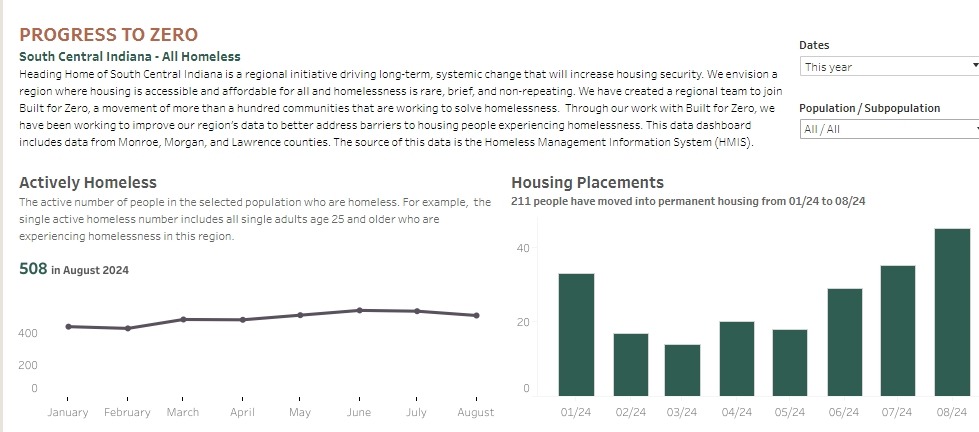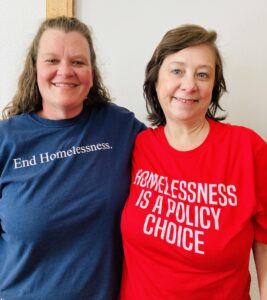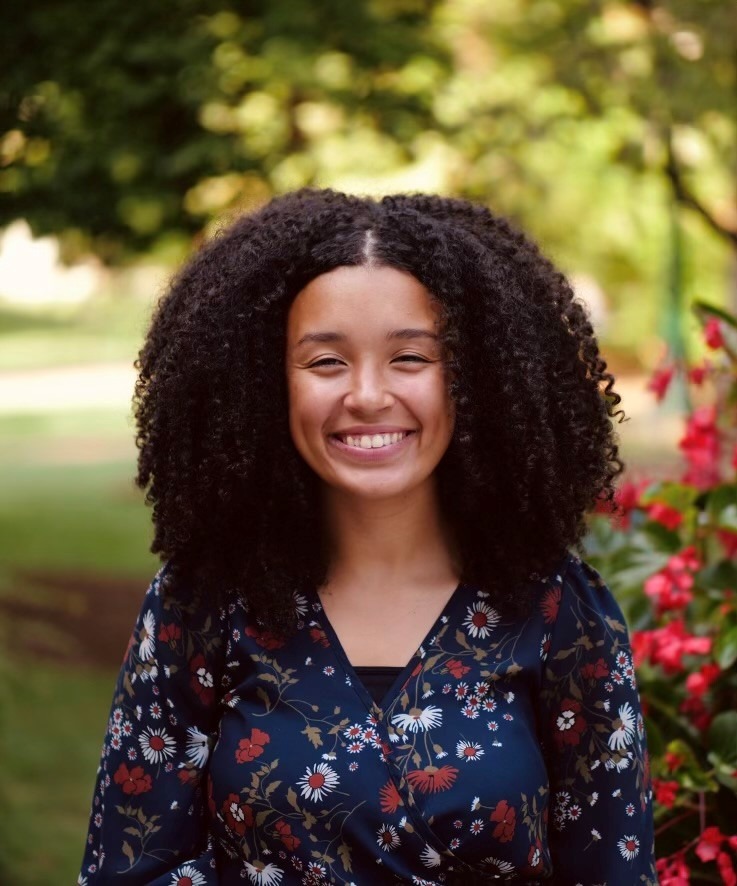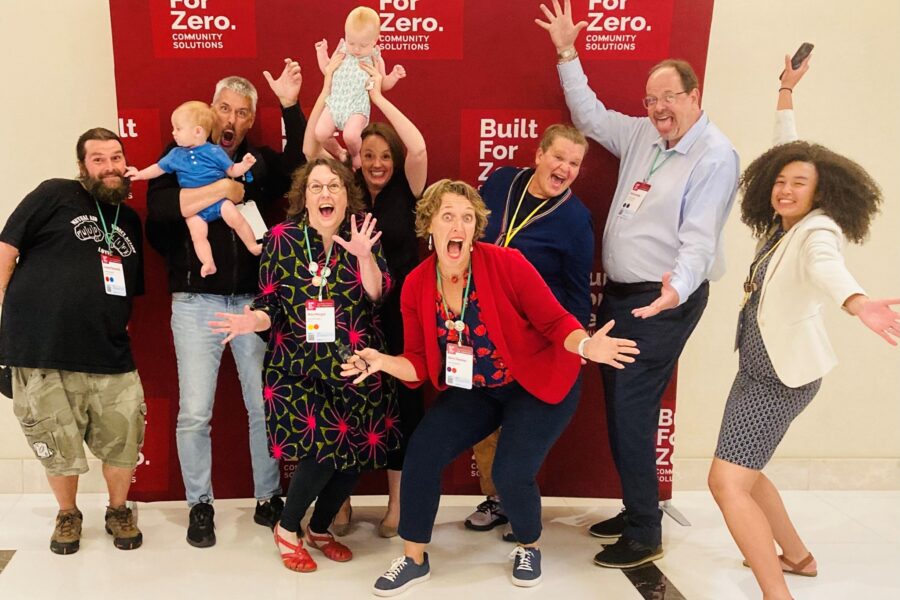The Mayor of Bloomington, Indiana, knows that quality, by-name data is crucial to solving homelessness.
“Data is really critical to us because, first of all, we’re a university community and people here trust nothing unless you have data,” explained Mayor Kerry Thomson. “We can’t make good plans unless we know where we’ve been and have some metric for understanding if we are getting there.”
The region of South Central Indiana recently achieved Built for Zero’s quality data milestone for all single adults, including veterans and those experiencing chronic homelessness. This milestone signifies a comprehensive, real-time data source that tracks homelessness across the region — a key step toward solving homelessness and reaching the community’s next goal of functional zero for veteran homelessness.
Covering a six-county region with 300,000 residents, the largely rural area includes the small city of Bloomington, which is also home to Indiana University Bloomington and most of the area’s homeless services. Despite three rural counties lacking shelters or services, the team has worked to ensure these areas are not overlooked, strengthening regional collaboration to better serve the entire community of South Central Indiana.
“It took more energy than we thought to convince people that quality data was important,” said Emily Pike, Executive Director of New Hope for Families. “Everyone thought their own data was quality, but we needed one clear set of data for our region to really understand the scope of the problem and work together to solve it.”

“We can’t make good plans unless we know where we’ve been and have some metric for understanding if we are getting there.”
— Kerry Thomson, Mayor of Bloomington, Indiana
Innovative solutions: Coordinated Entry Blitzes
By-name data, updated in real-time, provides a comprehensive picture of homelessness in a community. However, South Central Indiana faced a significant challenge: the largest shelter in Bloomington wasn’t using coordinated entry (CE), meaning many individuals were excluded from the broader homeless response system. Not only did this prevent these clients from having easier access to housing resources, but it also kept the South Central Indiana team from knowing exactly how many single adults were experiencing homelessness in their community.
While the shelter was a willing partner, they just did not have enough staff to consistently collect and enter data on their clients. As Pike explained, this was a moment when the team realized that if this shelter doesn’t have the capacity, it’s not a problem with the shelter — it’s a problem with the system.
“We need for all of the parts of our whole system to work. And if that means that we need to help, then we will help,” Pike said.
So, the team got creative. They created an event called a “Coordinated Entry Blitz,” where they brought together about 10 CE Assessors and went to the shelter one evening. Within three hours, they conducted more than 35 assessments of clients at the shelter, helping individuals access housing resources and complete applications for food stamps and Medicaid.
“We had several community partners come together,” said Melissa Burgess, Homeless Initiative Program Bloomington Coordinator at HealthNet. “It was an opportunity to break down barriers and start working better together.”
Since then, the team has held several CE Blitzes to ensure no one is missed, setting up wherever there’s a need. “We just identify gaps where we’re missing folks,” explained Burgess. “We’re pretty mobile — we can set it up as long as we have internet access. So we can host these blitzes wherever they’re needed.”

Tracking and sharing data publicly
Upon joining Built for Zero in 2022, South Central Indiana adopted a data-driven approach, setting a goal to create a public-facing dashboard to share real-time homelessness data.
“We wanted a place where we could all get on board with the same data and talk about it with a common base of knowledge,” said Mary Morgan, Director for Heading Home of South Central Indiana and BFZ Team Lead.
Previously, agencies relied on their own data or the annual Point-in-Time count, which offers only a snapshot of homelessness taken in one night.
With Built for Zero’s support, South Central Indiana developed their own dashboard, known as a performance management tracker. Now, the community has a powerful tool to track progress and share successes. The “PMT Lite” is available and used by Built for Zero communities across the network.
“It’s been really important that our community, service providers, donors and anyone interested in issues surrounding housing security can look at data that’s updated monthly,” said Tatiana Wheeler, Associate Director of Heading Home of South Central Indiana and BFZ Data Lead. “They can see in any given month how many households in our region are experiencing homelessness compared to how many households are moving into permanent housing.”
In 2023, 245 households moved into stable housing, with 211 more to date through August 2024. The team has also reduced the time it takes to identify housing for those in need from 200 to 163 days over the first half of the year. (Please note: the Data Dashboard reflects complete data from 2024 onward).
“Those are numbers we wouldn’t have known before this public dashboard was created,” noted Wheeler. “We have been able to champion those success stories and show that a lot is being done to resolve housing crises throughout our region and our system.”
The consistent, transparent data has also helped recast the narrative from focusing on homelessness to celebrating progress. “We’ve shifted from ‘We have all these people who are homeless’ to ‘Wow, we have all these people who’ve been housed,’” Morgan added. “It’s a more solutions-oriented way to understand what’s happening.”

Building a collaborative foundation
At its core, quality data fosters a healthier, more collaborative community. It encourages system leaders and service providers to unite across programs, shifting from isolated assistance to community-wide care.

“Our work with Built for Zero has emphasized that systems are stronger when stakeholders collaborate,” Wheeler said. “Throughout these past two years, we’ve been able to do things that initially seemed impossible, particularly with provider participation, ensuring 90-100% of people experiencing homelessness in our region are counted on our by-name list.”
Developing clear policies and procedures has also been crucial. These ensure sustainability and continuity, even amidst staffing or program changes: “We’re now trying to recognize how we can delegate and share knowledge, so our system can be resilient through every season,” Wheeler said.
Establishing and defining clear policies and procedures also helps create a shared understanding among the key participants in the homeless response system. As Pike explains, it wasn’t good enough to assume other partners and providers were operating in the same way.
“We needed to have a conversation with everyone and say, ‘Wait, are you doing what I think you’re doing? Because here’s what I’m doing,’” she explained. “We need to duplicate less and cover more. Getting to quality data isn’t possible unless we’re having those big conversations.”

“We’re now trying to recognize how we can delegate and share knowledge, so our system can be resilient through every season.”
— Tatiana Wheeler, Associate Director of Heading Home of South Central Indiana
Local solutions for local needs
With quality data in place, South Central Indiana plans to investigate the fairness of their homeless response system as they continue pursuing larger goals. Like so many other systems of care in America impacted by structural barriers, the homeless response system produces disparities. Systems can maintain or exacerbate these disparities — or work to dismantle them.
“Our first focus was, ‘How can we ensure all people experiencing homelessness are being added to our region’s by-name list?’” Wheeler said. “Now, we’re doing a deeper dive into our data to look at disparities and to continue to work on reaching functional zero for veterans.”
As Mayor Thomson emphasized, “We’re not looking for a cookie-cutter version to take from some other city and apply it here. We take the elements of what we think will be successful and then continue to iterate and innovate for our community.”
Sustaining these efforts requires significant investment. “The process is costly, and we can’t skimp on it, or we’re never going to make any progress,” Pike said. “When we’re able to do this all together, it’s easier to speak with one voice and say, ‘This is the path forward, and here’s how you can be a part of it.’”
The South Central Indiana team would like to thank all of the community members, organizations, and service providers who have contributed their time and effort in the collective work to end homelessness.
Melissa Burgess, HealthNet Homeless Initiative Program
Heather Flynn, Bedford Men’s Warming Shelter
Forrest Gilmore, Beacon Inc.
Bob Goodman, WellSpring
Mary Morgan, Heading Home of South Central Indiana
Emily Pike, South Central Housing Network and New Hope for Families
Scott Pietrovich, PLEH consultant and Indiana Recovery Alliance
Danielle Sorden, Coordinated Entry Lead and Beacon Inc.
Tatiana Wheeler, Heading Home of South Central Indiana




